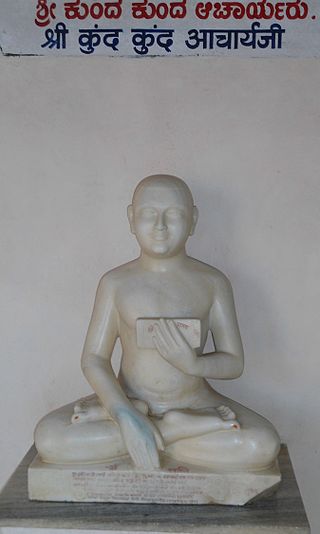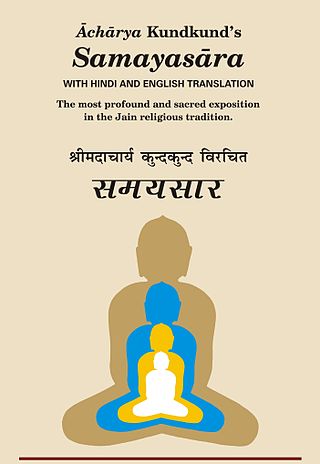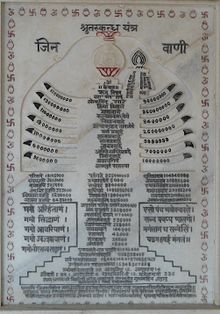
Kundakunda was a Digambara Jain monk and philosopher, who likely lived in the 2nd CE century CE or later.
Anekāntavāda is the Jain doctrine about metaphysical truths that emerged in ancient India. It states that the ultimate truth and reality is complex and has multiple aspects.

Tattvārthasūtra, meaning "On the Nature [artha] of Reality [tattva]" is an ancient Jain text written by Acharya Umaswami in Sanskrit, sometime between the 2nd- and 5th-century CE.

Karma is the basic principle within an overarching psycho-cosmology in Jainism. Human moral actions form the basis of the transmigration of the soul. The soul is constrained to a cycle of rebirth, trapped within the temporal world, until it finally achieves liberation. Liberation is achieved by following a path of purification.

Jain meditation (dhyāna) has been the central practice of spirituality in Jainism along with the Three Jewels. Jainism holds that emancipation can only be achieved through meditation or Shukla Dhyana. According to Sagarmal Jain, it aims to reach and remain in a state of "pure-self awareness or knowership." Meditation is also seen as realizing the self, taking the soul to complete freedom, beyond any craving, aversion and/or attachment. The practitioner strives to be just a knower-seer (Gyata-Drashta). Jain meditation can be broadly categorized to the auspicious and inauspicious. The 20th century saw the development and spread of new modernist forms of Jain Dhyana, mainly by monks and laypersons of Śvētāmbara Jainism.

Mallinatha was the 19th tīrthaṅkara "ford-maker" of the present avasarpiṇī age in Jainism. Jain texts indicate Mālliṇātha was born at Mithila into the Ikshvaku dynasty to King Kumbha and Queen Prajnavati. Tīrthaṅkara Māllīnātha lived for over 56,000 years, out of which 54,800 years less six days, was with omniscience.
Kaivalya is the ultimate goal of aṣṭāṅga yoga and means "solitude", "detachment" or "isolation", a vrddhi-derivation from kevala "alone, isolated". It is the isolation of purusha from prakṛti, and liberation from rebirth, i.e., Moksha. Kaivalya-Mukti is described in some Upanishads, such as Muktika and Kaivalya as the most superior form of Moksha which can grant liberation both within this life, as Jivanmukti, and after death, as Videhamukti.

Samayasāra is a famous Jain text composed by Acharya Kundakunda in 439 verses. Its ten chapters discuss the nature of Jīva, its attachment to Karma and Moksha (liberation). Samayasāra expounds the Jain concepts like Karma, Asrava, Bandha (Bondage), Samvara (stoppage), Nirjara (shedding) and Moksha.
The Fourteen Purva translated as ancient or prior knowledge, are a large body of Jain scriptures that was preached by all Tirthankaras of Jainism encompassing the entire gamut of knowledge available in this universe. The persons having the knowledge of purvas were given an exalted status of Shrutakevali or "scripturally omniscient persons". Both the Jain traditions, Svetambara and Digambara hold that all the fourteen purvas have been lost. According to tradition, the Purvas were part of canonical literature and deposited in the third section of Drstivada. Knowledge of Purvas became fairly vulnerable after Mahavira's nirvana (liberation) and on account of effects of famine, such that, eventually only one person—Bhadrabahu Svami had a command over it. In accordance with the prophecy of Mahavira, the knowledge of Purvas died within 1,000 years of his nirvana and eventually, the whole of Drstivada disappeared as well.(Bhagvati Sutra 20.8) However, a detailed table of contents of the Drstivada and the Purvas has survived in the fourth Anga, Samavāyānga and Nandīsūtra. Furthermore, certain portions of Drstivada and Purvas is said to have survived in Satkhandāgama and Kasāyaprabhrta, especially the doctrine of Karma.
Jain philosophy or Jaina philosophy refers to the ancient Indian philosophical system of the Jain religion. It comprises all the philosophical investigations and systems of inquiry that developed among the early branches of Jainism in ancient India following the parinirvāṇa of Mahāvīra. One of the main features of Jain philosophy is its dualistic metaphysics, which holds that there are two distinct categories of existence: the living, conscious, or sentient beings (jīva) and the non-living or material entities (ajīva).
Jain texts assign a wide range of meaning to the Sanskrit dharma or Prakrit dhamma. It is often translated as “religion” and as such, Jainism is called Jain Dharma by its adherents.
Kevala gyana or Keval gyan also known as Kaivalya means omniscience in Jainism and is roughly translated as complete understanding or supreme wisdom.

Sanskrit moksha or Prakrit mokkha refers to the liberation or salvation of a soul from saṃsāra, the cycle of birth and death. It is a blissful state of existence of a soul, attained after the destruction of all karmic bonds. A liberated soul is said to have attained its true and pristine nature of infinite bliss, infinite knowledge and infinite perception. Such a soul is called siddha and is revered in Jainism.
Jainism emphasises that ratnatraya — the right faith, right knowledge and right conduct — constitutes the path to liberation. These are known as the triple gems of Jainism and hence also known as Ratnatraya

Jain philosophy explains that seven tattva constitute reality. These are:—
- jīva- the soul which is characterized by consciousness
- ajīva- the non-soul
- āsrava (influx)- inflow of auspicious and evil karmic matter into the soul.
- bandha (bondage)- mutual intermingling of the soul and karmas.
- samvara (stoppage)- obstruction of the inflow of karmic matter into the soul.
- nirjara - separation or falling-off of parts of karmic matter from the soul.
- mokṣha (liberation)- complete annihilation of all karmic matter.

In Jainism, the principle of karma relates morality to the soul's cycle through life, death and rebirth. Moral actions accrue karma, which remain in the soul throughout the cycle, until liberation is achieved.
Jīva or Ātman is a philosophical term used within Jainism to identify the soul. As per Jain cosmology, jīva or soul is the principle of sentience and is one of the tattvas or one of the fundamental substances forming part of the universe. The Jain metaphysics, states Jagmanderlal Jaini, divides the universe into two independent, everlasting, co-existing and uncreated categories called the jiva (soul) and the ajiva. This basic premise of Jainism makes it a dualistic philosophy. The jiva, according to Jainism, is an essential part of how the process of karma, rebirth and the process of liberation from rebirth works.

Umaswati, also spelled as Umasvati and known as Umaswami, was an Indian scholar, possibly between 2nd-century and 5th-century CE, known for his foundational writings on Jainism. He authored the Jain text Tattvartha Sutra. Umaswati's work was the first Sanskrit language text on Jain philosophy, and is the earliest extant comprehensive Jain philosophy text accepted as authoritative by all four Jain traditions. His text has the same importance in Jainism as Vedanta Sutras and Yogasutras have in Hinduism.
Mithyātva means "false belief", and is an important concept in Jainism and Hinduism. Mithyātva, states Jayatirtha, cannot be easily defined as 'indefinable', 'non-existent', 'something other than real', 'which cannot be proved, produced by avidya or as its effect', or as 'the nature of being perceived in the same locus along with its own absolute non-existence'.

The sanskrit word Deva has multiple meanings in Jainism. In many places the word has been used to refer to the Tirthankaras. But in common usage it is used to refer to the heavenly beings. These beings are born instantaneously in special beds without any parents just like hell beings (naraki). According to Jain texts, clairvoyance based on birth is possessed by the celestial beings.













